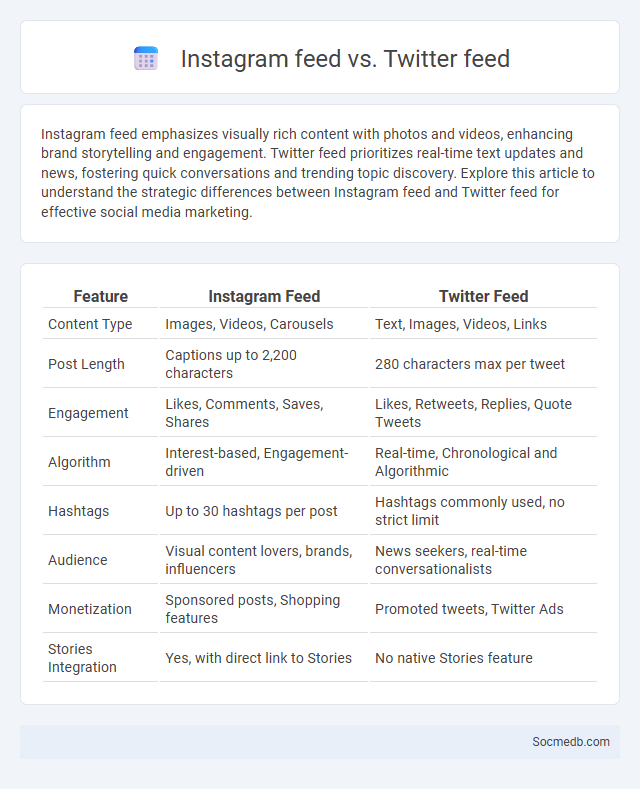
Photo illustration: Instagram Feed vs Twitter Feed
Instagram feed emphasizes visually rich content with photos and videos, enhancing brand storytelling and engagement. Twitter feed prioritizes real-time text updates and news, fostering quick conversations and trending topic discovery. Explore this article to understand the strategic differences between Instagram feed and Twitter feed for effective social media marketing.
Table of Comparison
| Feature | Instagram Feed | Twitter Feed |
|---|---|---|
| Content Type | Images, Videos, Carousels | Text, Images, Videos, Links |
| Post Length | Captions up to 2,200 characters | 280 characters max per tweet |
| Engagement | Likes, Comments, Saves, Shares | Likes, Retweets, Replies, Quote Tweets |
| Algorithm | Interest-based, Engagement-driven | Real-time, Chronological and Algorithmic |
| Hashtags | Up to 30 hashtags per post | Hashtags commonly used, no strict limit |
| Audience | Visual content lovers, brands, influencers | News seekers, real-time conversationalists |
| Monetization | Sponsored posts, Shopping features | Promoted tweets, Twitter Ads |
| Stories Integration | Yes, with direct link to Stories | No native Stories feature |
Introduction: Understanding Social Media Feeds
Social media feeds are dynamic streams of content curated by algorithms that prioritize user engagement, relevance, and recency. Platforms like Facebook, Instagram, and Twitter analyze user behavior, interests, and interactions to deliver personalized posts, advertisements, and updates. Understanding the mechanics behind these feeds is essential for optimizing content visibility and enhancing digital marketing strategies.
What is an Instagram Feed?
An Instagram feed is the main profile page where all of a user's posts, including photos and videos, are displayed in a grid format. It serves as a visual portfolio showcasing content in chronological order or based on engagement algorithms. The Instagram feed plays a crucial role in personal branding, influencer marketing, and business promotion by enabling users to curate their digital identity and attract followers.
What is a Twitter Feed?
A Twitter feed is a real-time stream of tweets displayed on a user's profile or homepage, showcasing posts from accounts they follow. It includes a mix of text, images, videos, retweets, and replies, offering a continuous update on trending topics and user interactions. The dynamic nature of a Twitter feed provides immediate access to news, opinions, and multimedia content shared within the Twitter network.
Defining the General Concept of a Feed
A social media feed is a dynamic stream of content that aggregates posts, updates, and multimedia from users, pages, or groups you follow, organized chronologically or by algorithmic relevance. This feed serves as the primary interface for discovering new information, engaging with shared content, and staying connected with your network. Understanding the feed's personalized nature helps optimize your experience by tailoring what content appears based on interactions and preferences.
Instagram Feed: Features and User Experience
Instagram Feed offers a dynamic visual platform where users can share photos, videos, and Stories, enhancing engagement through features like Likes, Comments, and Saves. The algorithm prioritizes content relevance based on your interactions, ensuring personalized and timely updates that keep your audience connected. Optimizing your Instagram Feed with high-quality visuals and consistent posting schedules significantly improves visibility and user experience.
Twitter Feed: Features and User Experience
Twitter Feed offers real-time updates with a chronological timeline that keeps users engaged through tweets, retweets, and trending topics. Its user experience emphasizes ease of navigation, customizable notifications, and content filtering to ensure you receive relevant and timely information. Advanced features like threaded conversations and multimedia integration enhance interaction and amplify user engagement.
Key Differences: Instagram Feed vs Twitter Feed
Instagram feed prioritizes visual content with high-resolution photos and short videos, enhancing user engagement through aesthetic appeal and storytelling. Twitter feed emphasizes real-time text updates, news, and trending topics, making it ideal for quick information sharing and conversations. Your choice depends on whether you want visually-driven content or immediate access to brief, topical updates.
Engagement and Algorithms Across Feeds
Social media platforms prioritize engagement metrics such as likes, comments, and shares to tailor algorithms that curate personalized feeds for users. These algorithms analyze user interactions and content preferences to boost visibility of relevant posts, enhancing overall user retention and activity. Optimizing content for these engagement signals significantly increases organic reach and platform influence.
Best Practices for Brands and Creators
Successful brands and creators leverage consistent content scheduling and audience engagement to boost visibility and foster loyalty on social media platforms. Utilizing data-driven insights and platform-specific trends enhances targeted campaigns, improving conversion rates and brand awareness. Integrating authentic storytelling with interactive features such as polls and live sessions increases user interaction and strengthens community bonds.
Conclusion: Choosing the Right Feed for Your Goals
Selecting the right social media feed depends on your specific goals, such as increasing brand awareness, driving engagement, or boosting sales. Understanding the audience demographics and content style of each platform ensures your feed aligns with your marketing objectives. Tailoring your strategy to fit these insights maximizes your impact and achieves your desired outcomes effectively.
 socmedb.com
socmedb.com